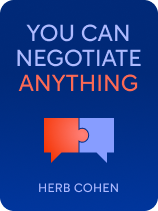

This article is an excerpt from the Shortform book guide to "You Can Negotiate Anything" by Herb Cohen. Shortform has the world's best summaries and analyses of books you should be reading.
Like this article? Sign up for a free trial here.
What’s a win-win negotiation? What are situations where a win-win negotiation is necessary?
Many people think of negotiation as a ruthless showdown between competitors, but it doesn’t have to be this way. Herb Cohen asserts that the most productive negotiations are win-win, in which two parties find a solution that’s better than what either would have come up with had they stated a list of demands.
Keep reading to learn how to get a win-win negotiation that pleases everyone.
How to Craft a Win-Win Negotiation
In a win-win negotiation, people are rarely fully aware of everything they want or of everything the other party is able to give them. In the process of negotiating terms and talking over various possibilities, both parties discover that they each have more to offer each other than they realize.
For example, imagine the owner of a multi-industry conglomerate wants to acquire a newsworthy 3D printing startup. However, the CEO of the printing firm refuses, wanting to retain as much control over their company as possible. Although this seems to be an impasse, the two parties agree to meet for a negotiation. Over the course of their discussion, the two executives discover that the conglomerate CEO foresees rapid growth in the 3D printer industry and wants to profit from this prediction. The 3D printing CEO wants to make sure they can continue pursuing their cutting-edge research and worries that new owners wouldn’t prioritize that mission.
This new understanding of each other’s goals allows the two executives to find a mutually beneficial solution: The 3D printing CEO accepts a sizable investment that allows the conglomerate CEO to get a slice of any future profits, while helping fund the printing firm’s current research goals.
(Shortform note: In Getting to Yes, Roger Fisher and William Ury argue that win-win negotiation is even more valuable in situations where time is of the essence. When both parties freely share information in search of mutually beneficial solutions, they’ll quickly discover any that exist. In contrast, the alternative to win-win negotiation—bargaining over specific demands—is extremely time-consuming, as negotiators often start with completely unreasonable demands and slowly make incremental compromises to try and get the best deal they can. Each new proposal has to be weighed by the other party, which only makes the negotiation last longer.)
Now that we’ve explained how win-win negotiation works, here are a few tips on how to conduct one successfully.
Tip #1: Establish the Common Goal of Fulfilling Everyone’s Desires
Cohen states that the first step in a win-win negotiation is to establish a common goal: Announce to the person you’re negotiating with that you want to find a solution that satisfies everyone’s desires. Then, get them to commit to seeking the same goal. This way, once you get into negotiation, both parties will actively search for win-win solutions.
If you fail to establish this common goal, the other negotiator will focus the conversation on whether you’ll give in to their various demands. This creates an unfriendly atmosphere that makes it much more difficult to brainstorm mutually beneficial solutions.
Tip #2: Build a Trusting Relationship
The most effective win-win negotiations are the result of an ongoing trusting relationship, argues Cohen. If two people have helped each other find mutually beneficial solutions in the past, they’ll trust that the other person isn’t trying to take advantage of them. Instead of hiding information that could be used against them, they’ll share everything relevant to the situation. This absolute transparency empowers them to work together to come up with the ideal solution for everyone.
To get someone to trust you, demonstrate your willingness to seek mutually beneficial solutions: Strive to see every situation from the other person’s perspective, and express genuine concern for their needs. Cohen recommends getting to know the other party on a personal level if possible.
Tip #3: Make Negotiation Pleasant
Win-win negotiation is about finding a solution that satisfies the desires of both parties. One way you can do this without making any sacrifices or concessions is by giving the other party the kind of negotiation they want. According to Cohen, if you make the negotiation process pleasant for the other party, they’ll be more willing to help you fulfill your desires.
Cohen notes that not everybody’s desires are the same: Get to know what kind of person the other negotiator is and tailor the negotiation to their specific needs. Most people want to be treated with kindness, respect, and empathy in negotiation. This is another reason it’s important to be friendly, even if the other party is outright hostile. However, for some people, the act of driving a hard bargain is what makes negotiation enjoyable. To satisfy them, you may need to give them the chance to haggle.
(Shortform note: Being kind, respectful, and empathetic in negotiation doesn’t always make it more pleasant for the other party. A study of one-time text-based negotiations found that sellers didn’t enjoy the process of negotiation any more when buyers acted warm and tried to make a personal connection. Researchers theorized that the downsides of engaging in friendly, conversational negotiation may have counterbalanced the desire to be treated with kindness: Friendly, personal negotiations take longer, and could make the sellers feel guilty for trying to get the best deal they can.)

———End of Preview———
Like what you just read? Read the rest of the world's best book summary and analysis of Herb Cohen's "You Can Negotiate Anything" at Shortform.
Here's what you'll find in our full You Can Negotiate Anything summary:
- Why you're a negotiator—even if you don't know it
- How to use the power of negotiation to create a better life for yourself
- Five tips on how to win at competitive negotiation






